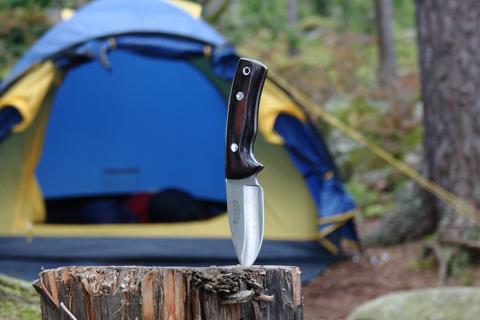
Is there a new camping knife in your future? To make the right choice there’s a lot to consider. Whether you’re a weekend family camper, a backpacker, or a hardcore wilderness survivalist there are good, better, and best solutions for you.
A camping knife, by old-school definition, is a fixed blade knife with a heavy-duty blade. It has a large handle, and it's basically a big, heavy indestructible knife. The drawbacks of the traditional camping knife are; it's big and it's heavy. Now, imagine you're at your favorite campground and strapping a 14-inch long knife across your chest. This is not a tool for making peanut butter and jelly sandwiches for the kids.
Enter the modern camping knife. Checkout our comprehensive list of pros and cons plus a glossary of camping knife terms unique to knives below. We've provided all the factors you'll need to consider in making your next selection.
The Camping Knife Glossary of Terms
 There are a number of terms unique to knives and you'll find it helpful to know them as you consider making your camping knife selection. Here's a list of the most important.
There are a number of terms unique to knives and you'll find it helpful to know them as you consider making your camping knife selection. Here's a list of the most important.
1. Belly: The curved part of the cutting edge usually close to the point of the knife blade
2. Grind (or main grind): The tapered surfaces of the knife blade going down from the spine (thickest) to the edge (thinnest).
3. Edge: The sharpened side of the blade.
4. Flipper: A protrusion on the tang of a folding knife that sits above the back of the pivot point in the closed position. Pulling back on the flipper with your index finger opens the knife easily.
5. Handle: The portion of the knife behind the blade, which is meant to be held in the hand to guide and steady the knife. Available in many designs, shapes, colors, and materials.
6. Choil: The underground part of the blade where it meats the Ricasso or becomes part of the handle. It is left at the full thickness of the spine for strength.
7. Lanyard Hole: The hole near the end of the knife handle opposite the blade meant for attaching a cord or strap.
8. Pivot Point: The attachment point or axel between the tang of the blade and handle of a folding knife
9. Pocket Clip: A metal clip attached to the back of a folding knife handle used to keep the knife at the top edge of the pocket for easy access.
10. Point: The extreme end of the blade where the lines of the edge and spine meet. There are many different styles of points.
11. Ricasso: The flat section of the blade between the handle and the start of the grind.
12. Spine: The side of the blade opposite the edge where it is the thickest. A traditional camping knife has a very thick spine and a fillet knife has a very thin spine.
13. Tang: The portion of the blade where it connects to the handle.
14: Thumb Stud: On may folding knives, a metal peg sits on the side of the blade where it pivots. By holding the back of the handle between your fingertips and palm, then applying upward pressure on the stud, you can easily open the knife one-handed.
Tip: Shop for knives, pocket knives, knife sharpeners, multi-tools, saws, machetes and axes at Bass Pro Shops here
Tip: Best Knife Sharpener Guide Video & Infographic
Click Choosing Your Camping Knife here for full size view of the infographic.

- 4407 views

